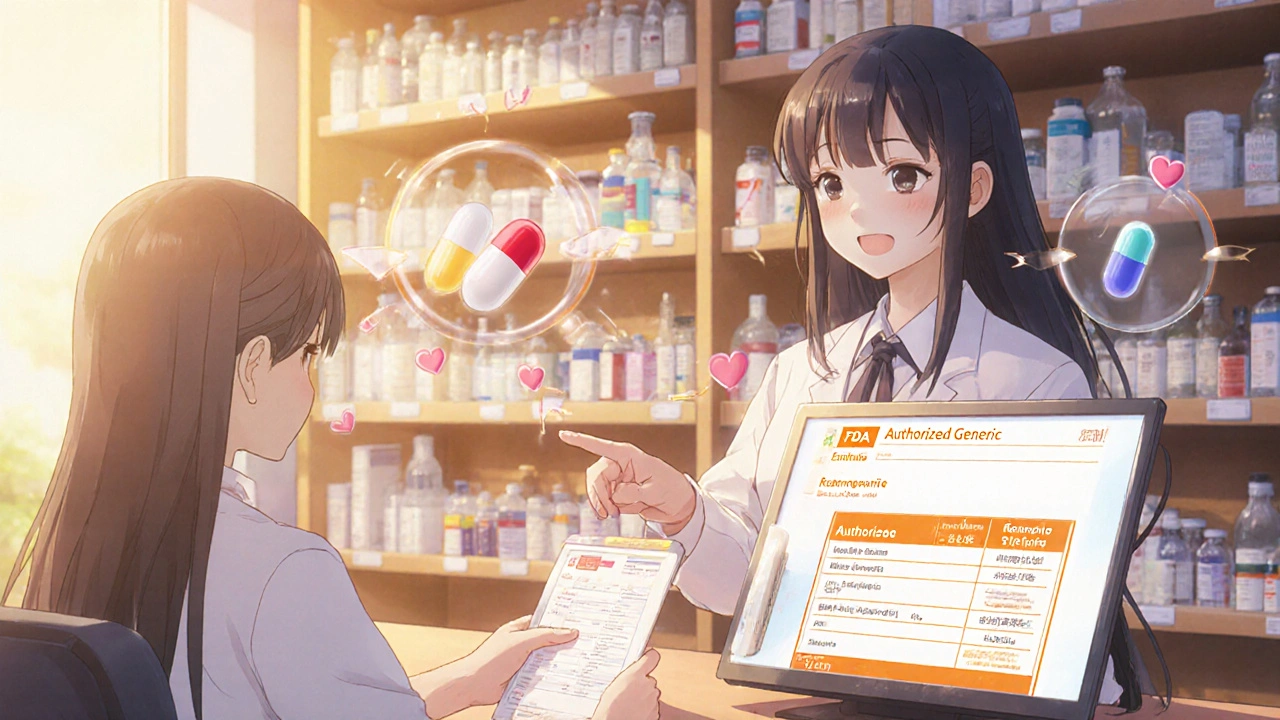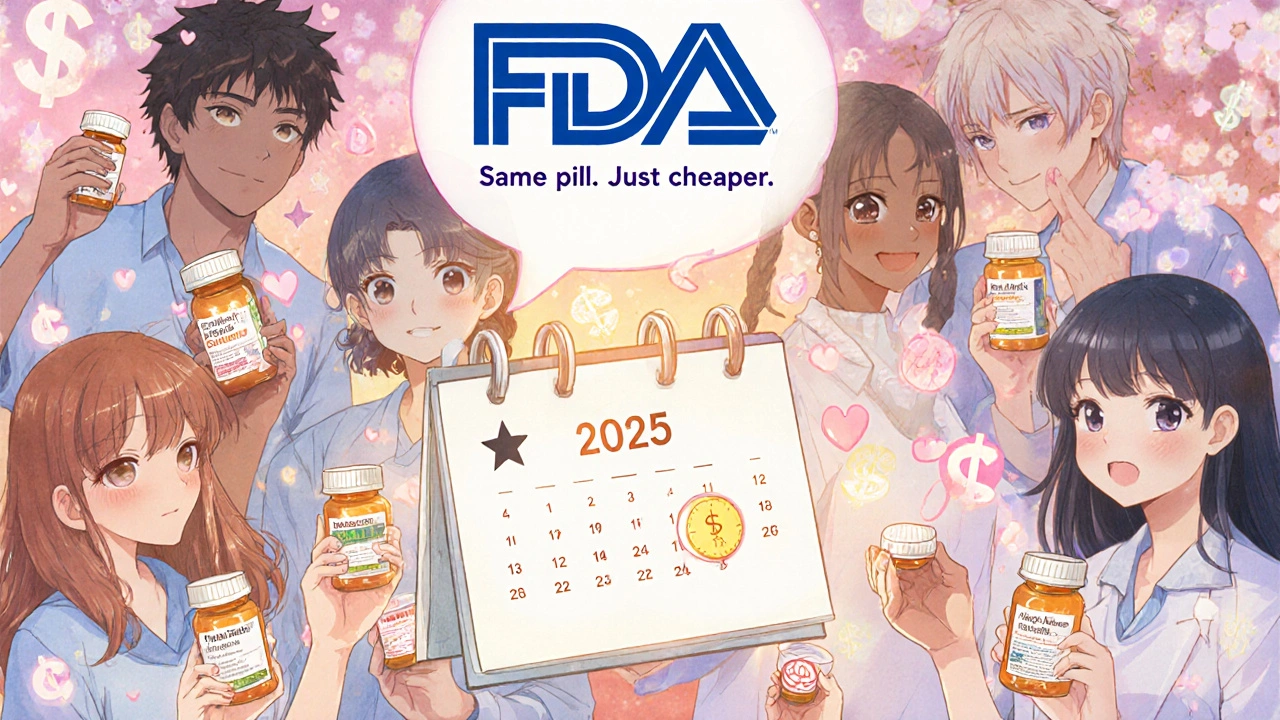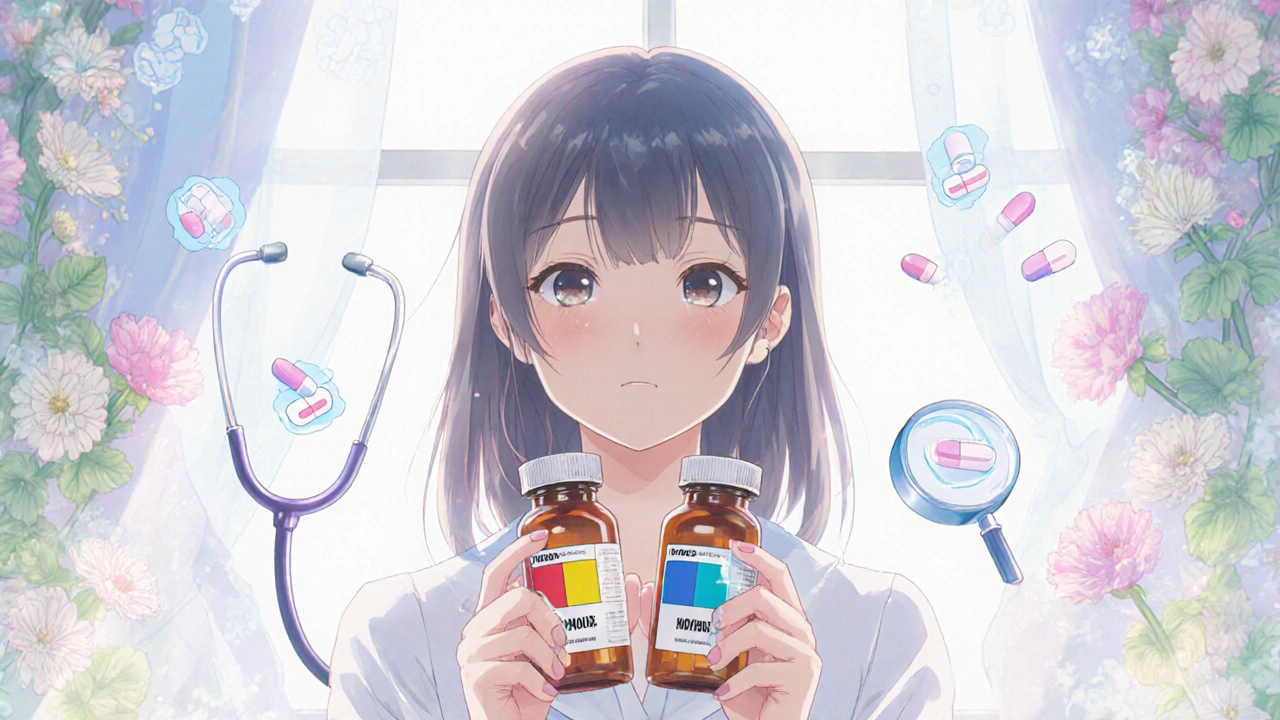When your prescription switches from a brand-name drug to a generic, it’s normal to feel uneasy. What if it doesn’t work the same? What if something changes in how you feel? The truth is, if you’re being switched to an authorized generic, you’re getting the exact same medicine-same active ingredients, same manufacturing process, same factory. The only difference? It doesn’t have the brand name on the bottle.
What Exactly Is an Authorized Generic?
An authorized generic is a brand-name drug sold without the brand name on the label. It’s made by the same company that makes the original drug, in the same facility, using the same ingredients and processes. The FDA requires these to be identical in every way to the brand version. Unlike regular generics, which must prove they’re bioequivalent through testing, authorized generics don’t need separate FDA approval-they’re covered under the original brand’s New Drug Application (NDA).This isn’t a knockoff. It’s the real thing, just repackaged. For example, if you take Lipitor (atorvastatin), the authorized generic is the exact same pill, but labeled simply as “atorvastatin calcium.” It’s the same color, same shape, same coating-sometimes even the same batch number. The only change is the label.
Why Do Authorized Generics Exist?
They were created under the 1984 Hatch-Waxman Act, which aimed to speed up generic drug access. But brand companies soon realized they could launch their own generic version to compete with other generics. By doing this, they can keep some market share while lowering prices. The Federal Trade Commission found that when an authorized generic enters the market, prices drop 8% to 18% faster than when only traditional generics are available.Here’s the twist: sometimes, the brand company launches the authorized generic right when the first generic competitor gets 180 days of exclusive rights. That means instead of one cheaper option, you get two-both cheaper than the brand. The result? Lower prices for everyone.
How to Tell If You’re Getting an Authorized Generic
Not every generic is an authorized generic. Many look similar, but they’re made by different companies with different inactive ingredients. To confirm you’re getting the real thing:- Check the FDA’s Orange Book and look for the “Authorized Generic” column.
- Ask your pharmacist: “Is this an authorized generic of my brand-name drug?”
- Compare the pill’s appearance to your old brand. If it looks identical, it’s likely an authorized generic.
- Look at the manufacturer name on the bottle. If it’s the same as the brand (e.g., Pfizer for Lipitor), it’s an authorized generic.
Don’t rely on price alone. Some traditional generics are cheaper than authorized generics. But if the pill looks and feels the same, and the manufacturer matches the brand, you’re getting the exact same product.
Why Switching to an Authorized Generic Is Safer Than Regular Generics
Regular generics must meet FDA standards, but they can differ in inactive ingredients-like fillers, dyes, or coatings. For most people, that’s fine. But for those with allergies or sensitivities (like lactose intolerance or dye reactions), even small changes can cause problems.Authorized generics eliminate that risk. Since they’re made by the same company using the same recipe, the inactive ingredients match the brand exactly. No surprises. No hidden allergens. No untested fillers.
A 2018 study in the National Center for Biotechnology Information found that patients switching to authorized generics had the same rates of hospitalization and medication discontinuation as those who stayed on the brand. That’s not true for all generics-some patients report side effects when switching to traditional generics, even when the active ingredient is the same.

What to Expect When You Switch
Most people notice no difference at all. But some do notice one thing: the pill looks different. That’s not because the medicine changed-it’s because the brand-name version had a unique color or logo, and the authorized generic doesn’t. The FDA allows manufacturers to change the appearance as long as the drug inside is identical.Here’s what patients commonly report:
- “My pill used to be blue. Now it’s white. Is this the same?” → Yes, if the manufacturer is the same.
- “I’ve been on this drug for years. I don’t want to change.” → You’re not changing the drug. You’re just changing the label.
- “My insurance forced me to switch. Will it still work?” → It will work better-because it costs less.
Pharmacists say about 65% of patient questions about authorized generics are about appearance. The answer is always the same: “It’s the same drug. The color change doesn’t affect how it works.”
Insurance and Cost: What You’ll Save
If your insurance plan covers the brand-name drug, you might be paying $50 or more per month. Switch to an authorized generic, and your copay often drops to $5-$15. In 2022, Medicare Part D data showed an average savings of $15-$30 per prescription when switching to an authorized generic.Most plans automatically switch you to the authorized generic if it’s available. You won’t get a choice-unless you ask. If you’re on a specialty tier drug, your plan might still require prior authorization. But if the authorized generic is on the formulary, it’s almost always cheaper than the brand.
Pro tip: Ask your pharmacist to check your plan’s formulary before you switch. Sometimes, the authorized generic is listed under a different name. Don’t assume your pharmacy will know.
How to Make the Switch Smooth
Switching doesn’t have to be stressful. Here’s how to do it right:- Ask your doctor: “Is there an authorized generic for this medication?”
- Call your pharmacy and ask: “Do you carry the authorized generic for [drug name]?”
- Check the FDA’s quarterly list of authorized generics to confirm it’s legitimate.
- When you get the new prescription, compare the pill to your old one. If it looks the same, you’re good.
- Keep your old bottle for a few weeks as a reference. If you notice any unusual side effects, contact your doctor.
- Update your medication list with your doctor or pharmacist so they know you’re on the authorized version.
Most patients adapt within days. Medication adherence rates stay above 85% after switching to authorized generics-same as staying on the brand.

Common Myths About Authorized Generics
- Myth: “Authorized generics are lower quality.” → False. They’re made in the same factory, by the same team, under the same rules.
- Myth: “They’re just rebranded generics.” → No. Regular generics are made by other companies. Authorized generics are made by the brand company.
- Myth: “I’ll get different results.” → Studies show no difference in effectiveness or side effects.
- Myth: “My doctor won’t approve it.” → Most doctors support it. It’s the same drug. Lower cost. Same outcome.
When You Should Avoid Switching
There are rare cases where switching isn’t recommended:- If you’ve had a severe reaction to any generic version in the past, even if it wasn’t an authorized one.
- If your drug has a narrow therapeutic index (like warfarin, levothyroxine, or cyclosporine), where tiny changes can matter. Even then, authorized generics are safer than traditional generics because they’re identical to the brand.
- If your insurance doesn’t cover the authorized generic and you can’t afford the brand.
For most people, though, switching is safe-and smart.
What’s Changing in 2025?
The FDA updated its reporting rules in 2020, making it easier to track authorized generics. Now, pharmacy systems automatically flag them when a prescription is filled. Many apps and online portals now show “Authorized Generic” next to the drug name.More brand companies are using authorized generics as part of their lifecycle strategy-especially for expensive specialty drugs. Morgan Stanley predicts that by 2028, 35% of biologic drugs losing patent protection will have authorized versions.
For patients, that means more savings, more transparency, and fewer surprises.
Final Advice: Don’t Fear the Switch
You’re not losing anything by switching to an authorized generic. You’re gaining lower costs, the same medicine, and the same safety profile. If your brand-name drug has an authorized version, ask your pharmacist. Ask your doctor. Ask your insurance.It’s the same pill. Just cheaper.
Is an authorized generic the same as a regular generic?
No. A regular generic is made by a different company and must prove it’s bioequivalent to the brand. An authorized generic is made by the original brand company, using the same formula and factory. It’s identical in every way-active ingredients, inactive ingredients, and manufacturing process.
Why does my authorized generic pill look different?
Because the brand name is removed from the label, the manufacturer can change the color, shape, or imprint to avoid trademark issues. But the drug inside is exactly the same. The FDA allows this as long as the active ingredient and dosage remain unchanged.
Can I ask my pharmacy to give me the brand instead of the authorized generic?
Yes, but your insurance may not cover it, and you’ll pay more. If you have a medical reason to avoid the switch (like a rare allergy), your doctor can write “Dispense as Written” on the prescription. Otherwise, switching saves money without sacrificing safety.
How do I know if a drug has an authorized generic?
Check the FDA’s quarterly updated list of authorized generics on their website. You can also ask your pharmacist or search the drug name + “authorized generic” online. If the manufacturer name matches the brand name, it’s an authorized generic.
Will my insurance automatically switch me to an authorized generic?
Yes, in most cases. Insurance plans prefer authorized generics because they’re cheaper than the brand and just as effective. If one is available, your pharmacy will dispense it unless your doctor specifically blocks the substitution.
Are authorized generics safe for long-term use?
Yes. Since they’re identical to the brand-name drug, they carry the same safety profile. Long-term studies show no increase in side effects or reduced effectiveness. Patients who switch to authorized generics maintain the same adherence and health outcomes as those who stay on the brand.


So let me get this straight-you’re telling me I’m paying $50 for a pill that’s literally identical to the one I can get for $5 because someone slapped a different label on it? This isn’t healthcare this is corporate theater with a side of emotional manipulation
Canada doesn’t even have this problem we just get the generic and it works fine stop overcomplicating things
Wow, this is such a nuanced and deeply important topic, and I just want to sit with it for a moment, because it touches on so many layers of trust, identity, and the quiet anxiety we carry about our own bodies when we’re told to accept something that looks different-even if we know, intellectually, that it’s the same. I’ve been on atorvastatin for eight years, and when my pill went from blue to white, I cried-not because I thought it wouldn’t work, but because I felt like my routine, my ritual, my sense of stability had been quietly erased. And yet, here’s the thing: I didn’t lose anything. I gained peace of mind knowing I was getting the exact same medicine, made by the same hands, in the same place. And that’s not just a pharmacological fact-it’s a human one. We’re not just pills and prescriptions; we’re people who need to feel safe, even when the world tries to make us feel like we’re settling. And this? This is a win. A quiet, uncelebrated, beautiful win.
Most people don’t realize that authorized generics are the only generics that don’t require bioequivalence studies because they’re literally the same product. That’s why they’re safer for people with sensitivities. If your pill looks the same and the manufacturer matches the brand, you’re golden. No need to overthink it
The FDA’s Orange Book is the definitive source, but pharmacy systems often misclassify authorized generics as traditional generics due to coding inconsistencies. Always cross-reference the NDC and manufacturer code. If the NDA holder is the same as the brand, it’s an authorized generic. This is critical for formulary compliance and adverse event tracking
My goodness, this is one of the most profoundly underappreciated victories in modern pharmaceutical policy. The fact that a company can, with integrity, produce its own generic version to undercut its own brand-thereby lowering costs for patients while maintaining quality-is nothing short of a quiet revolution. I’m not one for cheering corporate moves, but this? This is ethical capitalism at its most humane. Thank you for writing this. Truly.
Many people in India are unaware that authorized generics exist. We assume all generics are the same. This information is crucial. Please share this with more people. It could save lives by reducing fear and increasing adherence. Knowledge is power, and here, power means affordability and safety
I switched my mom to an authorized generic for her blood pressure med last year and she was terrified at first 😔 But now she says she doesn’t even notice the difference and saves $20 a month 💚 Thank you for explaining this so clearly!
I’ve been on an authorized generic for my thyroid med for over a year. No issues. No changes. Just lower copay. I’m glad the system works this way, even if it’s confusing at first.
It is imperative that patients understand that authorized generics are not merely rebranded generics; they are identical in composition, manufacturing process, and quality control. The distinction is not trivial-it is clinically and ethically significant. Misclassification leads to unnecessary patient anxiety and suboptimal adherence. Education is the cornerstone of safe medication use.
Look, I’ve been in pharma for 15 years and I can tell you this: if you’re not asking your pharmacist if it’s an authorized generic, you’re leaving money on the table and possibly risking side effects from fillers. Most people don’t know that the blue dye in the brand version of Lexapro? Totally gone in the generic. But not in the authorized one. So if you’re sensitive? You’re lucky. And if you’re not? You’re still paying too much. Also, the FDA doesn’t even track inactive ingredients in traditional generics-only authorized ones do. So yeah, this isn’t just about cost. It’s about control. And you’re being sold a myth if you think all generics are equal.
This is such a good reminder that sometimes the best thing you can do for your health is to let go of the logo. The pill doesn’t care what it’s called-it just works. And now you’re saving money. Win-win!
Why are people so gullible? You think a pill that looks different is the same? That’s just wishful thinking. I’ve seen people get sick after switching. Don’t be a fool.